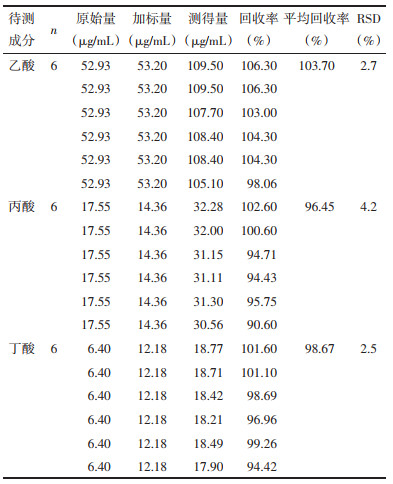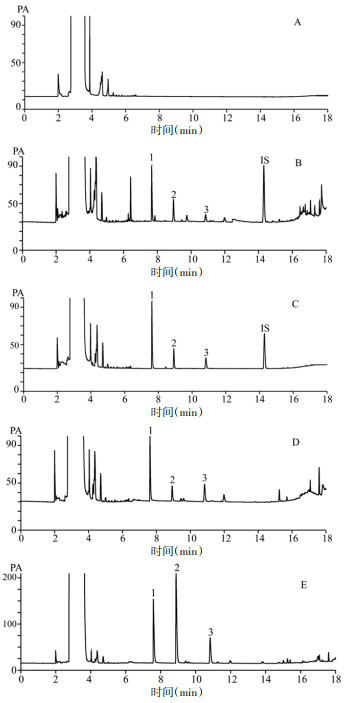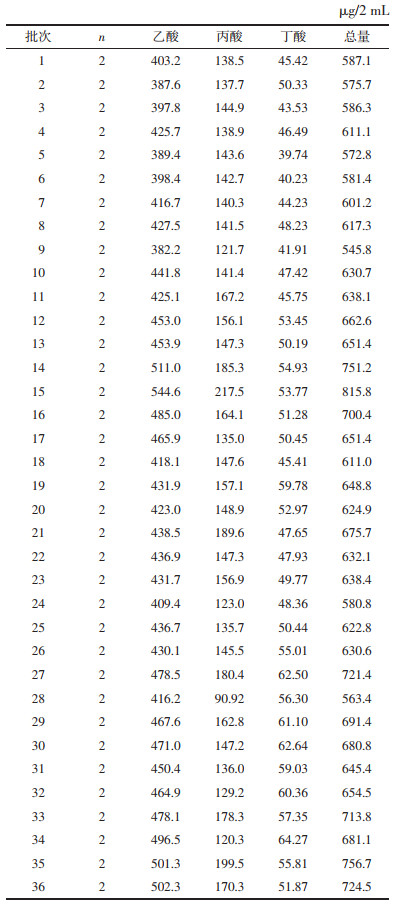文章信息
- 李灵云, 倪开岭, 李敏, 韩立峰, 杨静, 柴欣, 王跃飞
- LI Lingyun, NI Kailing, LI Min, HAN Lifeng, YANG Jing, CHAI Xin, WANG Yuefei
- 气相色谱法快速测定疏血通注射液中乙酸、丙酸、丁酸的含量
- Rapid determination of acetic acid, propionic acid and butyric acid in Shuxuetong Injection by gas chromatography
- 天津中医药, 2020, 37(1): 99-103
- Tianjin Journal of Traditional Chinese Medicine, 2020, 37(1): 99-103
- http://dx.doi.org/10.11656/j.issn.1672-1519.2020.01.21
-
文章历史
- 收稿日期: 2019-10-29
2. 牡丹江友搏药业有限责任公司, 牡丹江 157011
心脑血管疾病已经成为威胁人类健康的主要疾病,具有高发病率、高致残率、高病死率的特点[1]。据世界卫生组织(WHO)统计,2008年全球死于心脑血管疾病的人数高达1 730万人,占全球死亡人数的30%。到2030年全球预计将有2 360万人死于心脑血管疾病[2]。中国心脑血管疾病形势也日益严峻,自1990年以来中国心脑血管疾病患者逐年递增,2013年心脑血管病死率占全国总病死率的40.7%,2010至2030年仅考虑人口增长因素,中国的心脑血管疾病发生率将持续增加[3]。面对日益增加的心脑血管疾病患者,寻找安全有效的防治药物和治疗方法已成为心脑血管疾病防治的迫切要求。
中医药在防治心脑血管疾病方面具有独特优势,川芎、红花、水蛭等活血化瘀类中药及其复方制剂在治疗心脑血管疾病方面具有良好的临床疗效[4]。疏血通注射液是由水蛭和地龙制成的一种主要应用于急性脑卒中的中药注射剂,水蛭作为传统中药,具有破血通经,逐瘀消癥的功效,临床主治心脑血管疾病,包括急性心肌梗死、冠心病心绞痛、高血压、脑出血、脑梗死等,化学成分包括多肽、氨基酸、糖脂、碟啶、甾体及羧酸酯等化合物[5-6]。地龙性寒、味咸,具有痛经活络、平肝息风、清热止惊的功效,研究报道地龙具有抗炎镇痛、降脂、抑制血小板聚集等作用,化学成分主要包括蛋白质、多肽、氨基酸、有机酸类、核苷等化合物[7-8]。
短链脂肪酸(SCFAs)主要由肠道微生物代谢碳水化合物及蛋白质形成,分为直链型[甲酸(FA)、乙酸(AA)、丙酸(PA)、丁酸(BA)、戊酸(VA)、己酸(HA)]与支链型[异丁酸(i-BA)、异戊酸(i-VA)][9]。研究发现短链脂肪酸与高血压、高血脂、高血糖以及动脉粥样硬化等心脑血管疾病的发生发展联系密切[9-12]。乙酸、丙酸、丁酸占人体中短链脂肪酸的95%以上[13],其具有明显的活性,发挥重要的生理作用。乙酸可通过短链脂肪酸受体FFAR2影响胰岛素的分泌,丙酸具有抗炎、降脂、降低血糖的生理作用,丁酸可预防和抑制结肠癌,具有降血糖,降低胆固醇的作用[14-16]。研究发现疏血通注射液中含有大量的乙酸、丙酸、丁酸,因此有必要对疏血通注射液中的乙酸、丙酸、丁酸进行检测分析,为更好的控制疏血通注射液的质量提供依据。
短链脂肪酸的分析方法较多,如气质联用法(GC-MS)、液质联用法(LC-MS)、毛细管电泳法(CE)等[17-19]。由于短链脂肪酸无紫外吸收且极易挥发,采用液相色谱法、毛细管电泳法串联紫外检测器测定时,样品需进行衍生化处理,操作过程繁琐、耗时较长,与气质联用法相比,使用气相色谱法测定疏血通注射液中短链脂肪酸更加方便快捷[19-21]。采用气相色谱法直接测定疏血通注射液中乙酸、丙酸、丁酸,无需衍生化,方法简单、快速、准确、专属性强、灵敏度高、重现性好,可以准确有效的分析疏血通注射液中乙酸、丙酸、丁酸含量。
1 仪器与材料GC-7890B气相色谱仪(美国Agilent公司);DB-FFAP毛细管柱(30.00 m×0.25 mm×0.25 μm;美国Agilent公司);XS205十万分之一电子天平、AL204万分之一电子天平(瑞士METTLER TOLEDO公司);SB25-12DTN超声波清洗器(宁波新芝科技有限公司);XH-C振动搅拌器(金坛市医疗仪器厂)。
无水乙醇、浓盐酸(天津大茂化学试剂厂),超纯水(美国Millipore超纯水制备系统),对照品乙酸(批号:BCBL0846V)、丙酸(批号:BCBK5018V)、丁酸(批号:BCBH0489V)、2-乙基丁酸对照品(批号:STBD2230V)均购自美国Sigma-Aldrich公司。36批疏血通注射液(2 mL/支)与水蛭、地龙药材均来自牡丹江友博药业股份有限公司。
2 方法 2.1 对照品溶液的制备取乙酸、丙酸、丁酸对照品适量,精密称定,分别置于10 mL容量瓶中,加75%乙醇溶液定容,得到对照品储备液,浓度分别为乙酸10.63 mg/mL、丙酸3.192 mg/mL、丁酸1.739 mg/mL;取2-乙基丁酸(2-eBA)对照品适量,精密称定,置于100 mL容量瓶中,以75%乙醇进行定容,得浓度为628.7 μg/mL的内标储备液,置于4 ℃冰箱中备用。
分别取各对照品及内标储备液适量,于10 mL容量瓶中,加浓盐酸100 μL,以75%乙醇溶液定容,得到混合对照品溶液,浓度分别为乙酸1 063.3 μg/mL、丙酸240.0 μg/mL、丁酸150.0 μg/mL、2-乙基丁酸22.0 μg/mL,并采用75%乙醇溶液(含1%盐酸,2-乙基丁酸22.0 μg/mL)1:1逐级稀释成一系列不同浓度的混合对照品溶液。
2.2 供试品溶液的配制疏血通注射液样品0.5 mL置于离心管中,加1.5 mL 1.5%盐酸乙醇溶液(含内标2-乙基丁酸29.5 μg/mL),混匀,作为供试品溶液。
水蛭、地龙粉末各0.5 g置于10 mL容量瓶中,加1%盐酸乙醇溶液振摇,混匀,作为水蛭、地龙供试品溶液。
2.3 色谱条件色谱柱:DB-FFAP弹性石英毛细管柱;升温程序:初始温度50 ℃保持1 min,以15 ℃/min升至120 ℃后保持6 min,以7 ℃/min升至135 ℃保持1 min,以100 ℃/min升至230 ℃后保持3 min,进样口温度:240 ℃,检测器(FID)温度:240 ℃,进样体积:3 μL,分流比:10:1,载气:高纯氮气(N2),纯度 > 99.999%,流速1.0 mL/min,尾吹气:高纯氮气(N2),纯度 > 99.999%,流速25 mL/min,氢气流速30 mL/min,空气流速400 mL/min。
3 结果与讨论 3.1 方法学验证取“2.1”项下配制的一系列不同浓度的混合对照品溶液,按照“2.3”项下色谱条件进样分析。记录色谱峰峰面积,以对照品浓度X(μg/mL)为横坐标,以各化合物峰面积(AST)与内标物峰面积(AIS)比值

|
按照“2.2”项下方法制备疏血通注射液供试品溶液,进行日内精密度、日间精密度(每日分别制备供试品溶液)、重复性和稳定性实验。日内精密度RSD均小于2.4%,日间精密度RSD均小于0.66%,重复性实验表明:疏血通注射液中乙酸含量211.70 μg/mL,丙酸含量70.20 μg/mL,丁酸含量25.60 μg/mL,RSD均小于1.3%;各化合物在室温条件下8 h内稳定性良好,RSD均小于2.3%,结果见表 1。
在此基础上,开展疏血通注射液中乙酸、丙酸、丁酸含量测定的加样回收率实验。取疏血通注射液250 μL,加入与样品中乙酸、丙酸、丁酸量相当的对照品溶液500 μL(含乙酸106.4 μg/mL、丙酸28.73 μg/mL、丁酸24.35 μg/mL),加入75%乙醇(含2%盐酸,内标2-乙基丁酸35.20 μg/mL)1.25 mL,混匀,按照“2.3”项下色谱条件分析,乙酸、丙酸、丁酸平均加样回收率为96.45%~103.70%,RSD均小于4.2%,结果见表 2。

|
采用建立的气相色谱-氢焰离子化检测器方法分析了疏血通注射液中乙酸、丙酸、丁酸,气相色谱图见图 1,结果显示各酸分离良好,空白溶剂对其测定无干扰,原料药水蛭、地龙样品中均含有乙酸、丙酸、丁酸。对36批疏血通注射液进行含量测定,结果如表 3所示,疏血通注射液中乙酸含量为382.2~544.6 μg/支,丙酸含量为90.92~217.5 μg/支;丁酸含量为39.74~64.27 μg/支;乙酸、丙酸、丁酸的总含量为545.8~815.8 μg/支。3种短链脂肪酸中乙酸相对含量最高,丙酸次之,丁酸最低,各酸含量差异较大,3种酸总含量相对稳定。

|
| 1.乙酸;2.丙酸;3.丁酸;IS.2-乙基丁酸 图 1 空白溶剂(A)、疏血通样品(B)、混合对照品溶液(C)、地龙样品(D)、水蛭样品(E)的气相色谱图 Fig. 1 Gas chromatograms of blank solution (A), sample solution of Shuxuetong Injection (B), mixed standards solution (C), earthworm samples (D), leech samples (E) |

|
2015年版中国药典一部附录水蛭药材为蚂蟥、水蛭和柳叶蚂蟥的干燥全体,地龙药材为参环毛蚓、通俗环毛蚓、威廉环毛蚓和栉盲环毛蚓除去内脏的干燥体[22]。疏血通注射液由水蛭与地龙提取、精制而成,将水蛭、地龙药材分别置于0.9%氯化钠溶液中浸渍24 h绞碎研磨制成匀浆,匀浆液反复冻融、离心,分取上清液,超滤柱粗滤,滤液热压处理得水蛭、地龙提取液,提取液混匀超滤,除菌,分装即可。疏血通注射液在制备过程中未引入含乙酸、丙酸、丁酸的试剂,而水蛭与地龙药材的气相分析结果显示两种药材中均含有乙酸、丙酸、丁酸,因此推断疏血通注射液中的乙酸、丙酸、丁酸源自水蛭和地龙。
综上所述,本研究建立的疏血通注射液中乙酸,丙酸,丁酸的含量测定方法简便、快速、灵敏,为更好的控制该注射液的质量提供了依据,也为中药注射液的质量控制研究提供了参考。
| [1] |
MOZAFFARIAN D, BENJAMIN E J, GO A S, et al. Heart disease and stroke statistics-2016 update:a report from the American Heart Association[J]. Circulation, 2016, 133(4): 1-360. |
| [2] |
BALAKUMAR P, MAUNG-U K, JAGADEESH G. Prevalence and prevention of cardiovascular disease and diabetes mellitus[J]. Pharmacological Research, 2016, 113: 600-609. DOI:10.1016/j.phrs.2016.09.040 |
| [3] |
ZHANG M, JIANG Y, WANG L M, et al. Prediction of 10-year atherosclerotic cardiovascular disease risk among adults aged 40-79 years in China:a nationally representative survey[J]. Biomedical and Environmental Sciences, 2017, 30(4): 244-254. |
| [4] |
陈博年. 活血化瘀类中药注射剂在治疗急性脑梗死中的临床应用[J]. 天津药学, 2017, 29(4): 72-75. CHENG B N. Clinical applications on with promoting blood circulation to remove blood stasis type of TCM injections in treating acute cerebral infarction[J]. Tianjin Pharmacy, 2017, 29(4): 72-75. DOI:10.3969/j.issn.1006-5687.2017.04.022 |
| [5] |
黄秋阳, 冷静, 甘奇超, 等. 水蛭及其制剂在心脑血管疾病中的应用[J]. 中成药, 2019, 41(8): 1915-1920. HUANG Q Y, LENG J, GAN Q C, et al. Application of leech and its preparation in cardiovascular and cerebrovascular diseases[J]. Chinese Traditional Patent Medicine, 2019, 41(8): 1915-1920. DOI:10.3969/j.issn.1001-1528.2019.08.033 |
| [6] |
郭晓庆, 孙佳明, 张辉. 水蛭的化学成分与药理作用[J]. 吉林中医药, 2015, 35(1): 47-50. GUO X Q, SUN J M, ZHANG H. Review of pharmacological effects and chemical compounds of leech[J]. Jilin Journal of Traditional Chinese Medicine, 2015, 35(1): 47-50. |
| [7] |
张玉, 董文婷, 霍金海, 等. 基于UPLC-Q-TOF-MS技术的广地龙化学成分分析[J]. 中草药, 2017, 48(2): 252-262. ZHANG Y, DONG W T, HUO J H, et al. Analysis on chemical constituents of Pheretima aspergillum by UPLC-Q-TOF-MS[J]. Chinese Traditional and Herbal Drugs, 2017, 48(2): 252-262. |
| [8] |
黄敬文, 高宏伟, 段剑飞. 地龙的化学成分和药理作用研究进展[J]. 中医药导报, 2018, 24(12): 104-107. HUANG J W, GAO H W, DUAN J F. Research on chemical composition and pharmacological effects of Geosaurus[J]. Guiding Journal of Traditional Chinese Medicine and Pharmacy, 2018, 24(12): 104-107. |
| [9] |
FELIZARDO R J F, WATANABE I K M, DARDI P, et al. The interplay among gut microbiota, hypertension and kidney diseases:the role of short-chain fatty acids[J]. Pharmacological Research, 2019(141): 366-377. |
| [10] |
LEGRAND P, BEAUCHAMP E, CATHELINE D, et al. Short chain saturated fatty acids decrease circulating cholesterol and increase tissue PUFA content in the rat[J]. Lipids, 2010, 45(11): 975-986. DOI:10.1007/s11745-010-3481-5 |
| [11] |
MANDALIYA D K, SESHADRI S. Short chain fatty acids, pancreatic dysfunction and type 2 diabetes[J]. Pancreatology, 2019, 19(2): 280-284. DOI:10.1016/j.pan.2019.01.021 |
| [12] |
OHIRA H, TSUTSUI W, FUJIOKA Y. Are short chain fatty acids in gut microbiota defensive players for inflammation and atherosclerosis?[J]. Journal of Atherosclerosis and Thrombosis, 2017, 24(7): 660-672. DOI:10.5551/jat.RV17006 |
| [13] |
PSAD K N, BONDY S C. Dietary fibers and their fermented short-chain fatty acids in prevention of human diseases[J]. Mechanisms of Ageing and Development, 2018, 15: 1-21. |
| [14] |
李晓冉, 薛耀明. 醋酸敏感的G蛋白耦联受体FFAR2调控胰岛素分泌机制的研究[J]. 中国循证心血管医学杂志, 2017, 9(3): 293-296. LI X R, XUE Y M. Mechanism of acetate-sensitive G protein-coupled receptor FFAR2 in regulating insulin secretion[J]. Chinese Journal of Evidence-Bases Cardiovascular Medicine, 2017, 9(3): 293-296. DOI:10.3969/j.issn.1674-4055.2017.03.11 |
| [15] |
AL-LAHHAM S H, PEPPELENBOSCH M P, ROELOFSEN H, et al. Biological effects of propionic acid in humans; metabolism, potential applications and underlying mechanisms[J]. Biochim Biophys Acta, 2010, 1801(11): 1175-1183. DOI:10.1016/j.bbalip.2010.07.007 |
| [16] |
SOSSAI P. Butyric acid:what is the future for this old substance?[J]. Swiss Medical Weekly, 2012, 6(142): 1-4. |
| [17] |
HAN X, GUO J, YOU Y, et al. A fast and accurate way to determine short chain fatty acids in mouse feces based on GC-MS[J]. Journal Chromatography B-Analytical Technologies in the Biomedical and Life Sciences, 2018, 1(1099): 73-82. |
| [18] |
NAGATOMO R, OKADA Y, ICHIMURA M, et al. Application of 2-picolylamine derivatized ultra-high performance liquid chromatography tandem mass spectrometry for the determination of short-chain fatty acids in feces samples[J]. Analytical Sciences, 2018, 34(9): 1031-1036. DOI:10.2116/analsci.18SCP10 |
| [19] |
KONG J, SHI J, CHEN Z, et al. Tributyl phosphate assisted hollow-fiber liquid-phase microextraction of short-chain fatty acids in microbial degradation fluid using capillary electrophoresis-contactless coupled conductivity detection[J]. Journal of Pharmaceutical and Biomedical Analysis, 2018, 30(154): 191-197. |
| [20] |
IGARASHI H, OHNO K, MATSUKI N, et al. Analysis of fecal short chain fatty acid concentration in miniature dachshunds with inflammatory colorectal polyps[J]. Journal of Veterinary Medical Science, 2017, 79(10): 1727-1734. DOI:10.1292/jvms.17-0165 |
| [21] |
MISHIMA E, FUKUDA S, MUKAWA C, et al. Evaluation of the impact of gut microbiota on uremic solute accumulation by a CE-TOF MS-based metabolomics approach[J]. Kidney International, 2017, 92(3): 634-645. DOI:10.1016/j.kint.2017.02.011 |
| [22] |
国家药典委员会.中华人民共和国药典[S].第一卷, 北京: 中国医药科技出版社, 2015: 83, 122. National Commission of Chinese Pharmacopoeia. Pharmacopoeia of the people's republic of China[S]. First volume, Beijing: Chinese Medical Science and Technology Press, 2015: 83, 122. |
2. Mudanjiang Youbo Pharmaceutical Co., LTD., Mudanjiang 150711, China
 2020, Vol. 37
2020, Vol. 37




